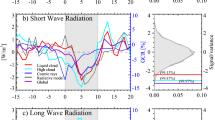Abstract
The electrification of thunderstorms is the result of charge transfer during interactions between cloud and precipitation particles1–4. Many laboratory studies with initially uncharged particles5–10 have shown that charge is transferred when ice crystals collide with soft hailstones, the charge magnitudes being highly dependent on cloud conditions. Here we describe laboratory experiments which show that the charge transferred during collisions of this type is adequate to account for thunderstorm electrification, but that the net charge transfer is limited, perhaps as a result of local corona breakdown. Light emission from the corona has now been detected. Relatively large charge transfers may occur during contact, but this charge remains essentially localized at the interacting surfaces long enough for corona discharge to cause some charge to return as the particles separate. These results indicate the need for revised charge transfer values in models of thunderstorm electrification.
This is a preview of subscription content, access via your institution
Access options
Subscribe to this journal
Receive 51 print issues and online access
$199.00 per year
only $3.90 per issue
Buy this article
- Purchase on Springer Link
- Instant access to full article PDF
Prices may be subject to local taxes which are calculated during checkout
Similar content being viewed by others
References
Krehbiel, P. R., Brook, M. & McCrory, R. A. J. geophys. Res. 84, 2432–2456 (1979).
Lhermitte, R. & Krehbiel, P. R. IEEE Trans. Geosci. Electron. GE17, 162–171 (1979).
Gardiner, B., Lamb, D., Pitter, R., Hallett, J. & Saunders, C. P. R. J. geophys. Res. 90, 6079–6086 (1985).
Dye, J. E. et al. J. geophys. Res. 91, 1231–1247 (1986).
Reynolds, S. E., Brook, M. & Gourley, M. F. J. Met. 14, 426–436 (1957).
Church, C. R. thesis, Univ. Durham (1966).
Marshall, B. J. P., Latham, J. & Saunders, C. P. R. Q. Jl R. met. Soc. 104, 163–178 (1978).
Gaskell, W. & Illingworth, A. J. Q. Jl R. met. Soc. 106, 841–854 (1980).
Jayaratne, E. R., Saunders, C. P. R. & Hallett, J. Q. Jl R. Met. Soc. 109, 609–630 (1983).
Keith, W. D. thesis, Univ. Manchester (1987).
Christian, H. et al. Q. Jl R. met. Soc. 106, 159–174 (1980).
Gaskell, W. Q. Jl R. met. Soc. 107, 955–966 (1981).
Caranti, J. M. & Illingworth, A. J. J. geophys. Res. 88, 8483–8489 (1983).
Mason, J. M. Proc. R. Soc. 415, 303–315 (1988).
Saunders, C. P. R. Weather 43, 318–324 (1988).
Hallett, J. & Saunders, C. P. R. J. atmos. Sci. 36, 2230–2235 (1979).
Jayaratne, E. R. & Saunders, C. P. R. J. geophys. Res. 90, 13063–13066 (1985).
Caranti, J. & Illingworth, A. J. Nature 284, 44–46 (1980).
Keith, W. D. & Saunders, C. P. R. Preprints Almos. Elec. Conf., Uppsala (1988).
Caranti, J. M. & Illingworth, A. J. J. phys. Chem. 87, 4078–4083 (1983).
Griffiths, R. F. & Latham, J. Q. J. R. met. Soc. 100, 163–180 (1974).
Author information
Authors and Affiliations
Rights and permissions
About this article
Cite this article
Keith, W., Saunders, C. Light emission from colliding ice particles. Nature 336, 362–364 (1988). https://doi.org/10.1038/336362a0
Received:
Accepted:
Issue Date:
DOI: https://doi.org/10.1038/336362a0
Comments
By submitting a comment you agree to abide by our Terms and Community Guidelines. If you find something abusive or that does not comply with our terms or guidelines please flag it as inappropriate.



